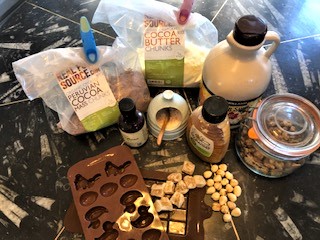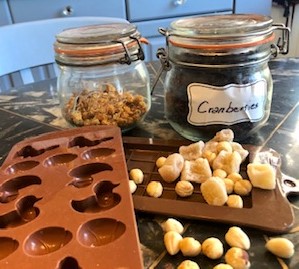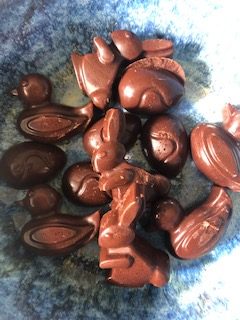Easter and chocolate go together like spring and daffodils. So what better time to indulge in a little chocolate making than Easter Monday? General craziness meant that my husband and I hadn’t made our treat packed baskets and I was missing that indulgence. There was a solution; however, and like most of our solutions this year, it lay in doing it ourselves.
In an act of self-interested generosity, I had bought my husband a chocolate making kit for Christmas. (He had expressed interest and who was I to deny him?) Using YouTube as his guide, he made a batch of the best chocolate I have ever tasted. He made another and then this time, I asked to be initiated into this most eminently useful skill.
Ingredients are key
As with all things culinary, the better the ingredients you have to start with, the better the result. Get organic and fair trade if you can. I found mine online and, though not cheap, would hardly break the bank either.

Chocolate’s ingredients are surprisingly few: cocoa mass, cocoa butter, sweetener and salt. Any flavours you wish can be added, but the base is just that. The really complicated part of transforming a sticky bean to cocoa mass/butter has been done for you.
The equipment too, is very straight forward. All that is required is a heat-proof bowl, a pot, and a wooden spoon. As your skills progress, you may wish to invest in a marble slab for tempering the chocolate and a sugar thermometer for ensuring temperatures are just right, but we are happy with our less than perfect version.
Chocolate for beginners recipe
After a little trial and error, this is the recipe we went with. It makes a dark chocolate that is vegan friendly.
Ingredients
200g of cocoa butter
300 g of cocoa solids
1 tsp of vanilla essence
Pinch of salt
Honey and maple syrup to taste
Method
Place the cocoa butter in a heat proof bowl and sit on a pot filled to a quarter with water (to make a bain-marie). Ensure that the bottom of the bowl isn’t touching the water. Bring the water to the simmer and then continue to heat gently until the cocoa butter melts. Stir all the while. When fully liquid, add the cocoa solids gradually and continue stirring. Do not over-heat and do not let any water come in contact with the chocolate or it will ruin it!
When all is liquid, add one teaspoon of vanilla essence, a pinch of salt and honey and pure maple syrup to taste. You can use liquid sugar but we love the taste of honey with a little smoky note of maple. Taste as you go – you’ll need quite a lot – and when it is on the bitter side of perfect – stop. The chocolate will get a little sweeter as it cools, so err on the bitter side.
Adding flavour
This is the fun part and you are limited only by your imagination. Chocolate is one of those rare foods that goes with almost everything – it is the little black dress of cooking. If you wish to infuse your chocolate with a flavour such as peppermint, substitute that for the vanilla above. I love rose geranium, but if you wish to add herbal/floral extracts make sure they are food safe first. Also, add only a few drops at a time. The good stuff is very intense.
Chocolate pairs well with stronger herbs such as rosemary, delicate florals like rose and spicy flavours such as chilli. For ideas, look up a gourmet chocolate shop or play with what you have to hand.

Roasted nuts and dried fruits are always going to be good. In the batch we made we had: crystallized ginger and crunched ginger thins; dried white mulberries; date and mango and whole roasted hazelnuts. Personally, I think that really strong contrast flavours work the best, so perhaps avoid any insipid ones.
Get set!
Now your chocolate is ready for the moulds. We bought a couple on Ebay and used cupcake trays for the remainder. Moulds can be expensive and if you just want to give it a try without investing too much, gorgeous chocolate called bark can be made by simply smearing it thickly onto a sheet of baking paper and sprinkling the additional components on top.

Before pouring the chocolate into the moulds, we sprinkle our extra ingredients on the bottom. They will float up a little bit when the liquid chocolate is added to give a lovely texture. Err on the conservative side when adding the chocolate. Add a spoonful at a time and leave a little space at the top. (Otherwise, it sloshes chocolate all over when you move it and makes it difficult to ease out the mould. I know this, because that is exactly what I did on the chocolate bar mould!) Top tip: If your mould is on the wobbly side, place on a baking tray before filling, that way you can move it about with ease.
Now wait
This is clearly the hardest part of the operation – waiting for the chocolate to set. It takes several hours and patience is key. Ideally, place the chocolate in a cool part of the house away from pets. (Chocolate is poisonous to dogs.) Make a cup of tea, read a magazine and only a few hours later, check its progress. It should be hard and shiny(ish) on the top and pop out the mould easily if fully set.

The joy of chocolate making is that it makes a lot. This recipe makes about one pound: that means plenty for you and plenty to share. If giving as a gift, it can be wrapped prettily in cellophane or bars can be wrapped in wax paper with a colourful paper sleeve. However you present it, though, it will taste great.
And the third chocolatier? Hermione, of course, whose contribution was to entertain us while we cooked.
